Exploring Libyan Desert Glass: Formation and Significance

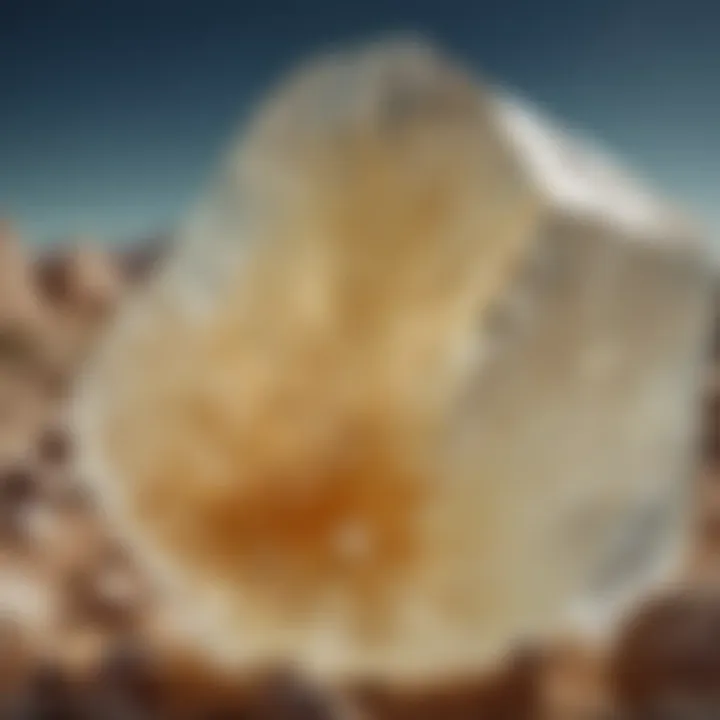
Intro
Libyan Desert Glass, also known as Great Sand Sea glass, captures the curiosity of many due to its unique properties and mysterious origins. These natural artifacts are not just beautiful; they embody intricate geological processes and rich historical significance. As researchers and collectors dive into the world of this remarkable tektite, they unveil insights that connect ancient history to modern science. This overview articulates the complexities surrounding Libyan Desert Glass, aiming to serve as a guide for enthusiasts and professionals interested in this captivating material.
History and Origins
Libyan Desert Glass has a storied past, with its origins deeply rooted in natural phenomena. This section examines how these tektites came to be and their significance in various cultures.
Overview of Collectibles, Rocks, and Fossils
In the broader context of geology and paleontology, Libyan Desert Glass occupies a unique space among collectibles. Its distinct yellow-green hue differentiates it from other minerals. Collectors often seek it due to its rarity and the enigma surrounding its formation. Unlike common stones, this glass-like substance is a testament to the Earth's dynamic history.
Historical Significance and Cultural Impact
Studies suggest that Libyan Desert Glass was valued in ancient times. Archaeological findings indicate that it was used to craft tools and jewelry by the early Egyptians. The glass' luster made it appealing for ornamental purposes. Additionally, its origins have prompted various cultural interpretations, linking it to divine or cosmic events. Understanding this historical context enriches the appreciation of Libyan Desert Glass as a collectible.
Identification and Classification
Identifying Libyan Desert Glass can be a rewarding process, especially for collectors. In this section, we explore how to recognize this tektite and its various forms.
Guide to Identifying Rocks and Fossils
When searching for Libyan Desert Glass, certain characteristics can help in identification:
- Color: Typically a translucent yellow-green or golden hue.
- Texture: Smooth, glassy surface often etched with natural patterns.
- Weight: Dense compared to regular glass due to its high silica content.
A careful examination of these features can reveal much about the specimen in hand, providing insight into its geological history.
Common Types and Variations
While Libyan Desert Glass is often categorized as a single type, variations do exist. These can depend on factors like formation conditions and geographical distribution. Some notable types include:
- Standard Libyan Desert Glass: The most collected version, known for its classic appearance.
- Fossilized Variants: Contains inclusions that may indicate its interaction with other materials over time.
- Cultural Relics: Pieces that have been worked or altered by human hands, showcasing historical craftsmanship.
Foreword to Libyan Desert Glass
Libyan Desert Glass is a captivating subject, essential for understanding not just geological phenomena, but also the broader context of our planet's history. As a tektite, it sparks interest among collectors and scientists alike due to its mysterious origins and aesthetic properties. This article seeks to illuminate the unique characteristics of Libyan Desert Glass and its significance in various fields.
Definition of Tektites
Tektites are natural glass objects formed from the intense heat and pressure generated during meteoric impacts. These materials are typically found far from the impact site, leading to a diverse range of physical appearances, shapes, and colors. Libyan Desert Glass, specifically, is renowned for its golden yellow hue, which sets it apart from other tektites. The formation process of these glassy artifacts involves molten materials that cool rapidly, solidifying into unique shapes that intrigue both collectors and researchers.
Historical Context
The history of Libyan Desert Glass stretches back thousands of years, with evidence of its use found in ancient Egyptian artifacts. This glass was not just appreciated for its beauty; it was used for tools and ornaments. Ancient Egyptians are believed to have crafted jewelry from this glass, sometimes embedding it in gold settings to create exquisite pieces.
Archaeological studies indicate that Libyan Desert Glass played a role in both trade and craftsmanship in ancient cultures, providing insights into the human interaction with natural resources. As scientific tools and technologies develop, the analysis of these artifacts continues to reveal a wealth of information about ancient societies and their use of materials at hand.
"Understanding the historical context of Libyan Desert Glass enriches our appreciation for its role in human history and craftsmanship."
In summary, the introduction of Libyan Desert Glass within this article serves as a gateway to explore its geological, social, and scientific dimensions, making it a topic of multifaceted interest.
Geological Formation of Libyan Desert Glass
The geological formation of Libyan Desert Glass is critical to understanding its unique properties and origins. This section delves into how these fascinating tektites were created, shaped by natural forces that offer insight into the history of our planet. By exploring the elements involved in this process, we can appreciate the complexities and significance of Libyan Desert Glass in the study of geosciences.
Impact Events and Their Role
Impact events are central to the creation of Libyan Desert Glass. These occurrences are typically the result of meteorite collisions with Earth. Such high-energy impacts generate intense heat and shockwaves that can liquefy silicate materials in the environment. Libyan Desert Glass likely originated from the melting of silica-rich sands in the Libyan desert due to a significant impact event.
Various researchers suggest that the most prominent theory is that a meteorite struck the region, creating the necessary conditions for the glass to form. The energy released during the impact leads to temperatures exceeding 1,700 degrees Celsius. This extreme heat melts sand quickly, solidifying into a glassy form upon cooling. The precise timeline of these events is still debated, but the connection between meteorite impacts and the formation of this glass cannot be overstated.
"The creation of Libyan Desert Glass exemplifies the dramatic outcomes of cosmic events impacting our planet, forging unique geological specimens."
Temperature and Pressure Conditions
Temperature and pressure conditions also play a vital role in the formation of Libyan Desert Glass. During an impact, the surrounding materials experience a sudden rise in temperature, but the duration of this heat influences the glass's properties. In areas where high pressure occurs, such as within a crater, the formation of different minerals and variations in glass occurs.
The cooling rate after the impact affects the final characteristics of the glass, including its color and clarity. Quick cooling fosters transparency, while slower cooling can lead to cloudiness or variations in color. This diversity in appearance provides valuable information for scientists and collectors alike, as each piece can tell its own story based on the conditions it underwent during formation.
In summary, understanding the geological formation of Libyan Desert Glass involves looking closely at both impact events and the specific temperature and pressure conditions present at the time of its creation. This knowledge enriches not only the study of tektites but also broader geological history, making Libyan Desert Glass a key area of interest for both researchers and collectors.
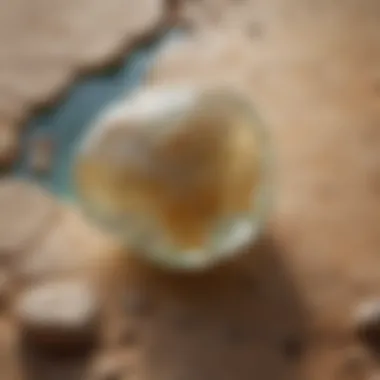
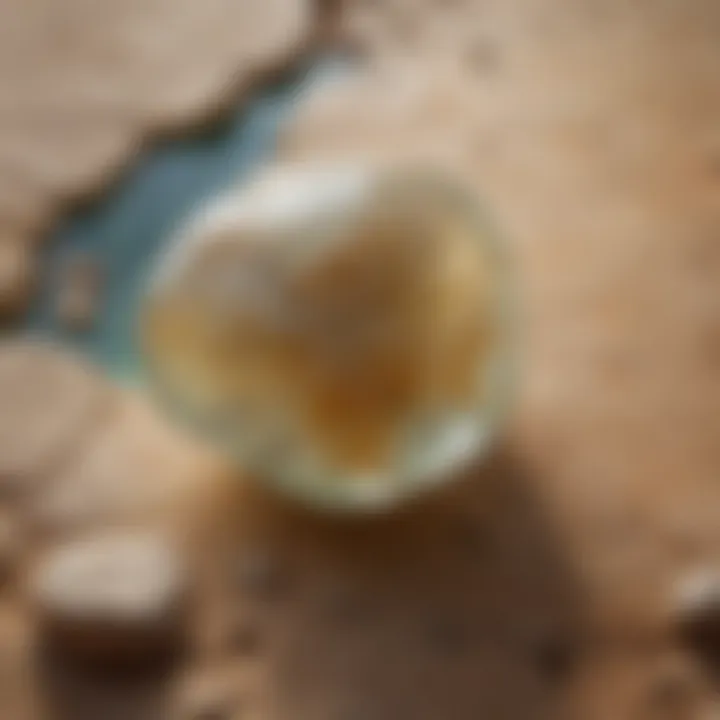
Physical Properties of Libyan Desert Glass
Understanding the physical properties of Libyan Desert Glass is crucial for both collectors and researchers. These properties provide insight into the formation and potential uses of this unique material. The striking physical characteristics not only enhance its aesthetic appeal but also contribute to its desirability in various applications. By exploring aspects like color, transparency, texture, and hardness, one can appreciate the complexity and allure of Libyan Desert Glass.
Color and Transparency
Libyan Desert Glass is renowned for its stunning colors, which range from golden yellow to translucent green. The variations in hue are primarily a result of the different mineral compositions and the conditions under which the glass formed. A notable characteristic of this tektite is its semi-transparency, allowing light to pass through. This feature enhances its beauty, making it a popular choice for jewelry making.
The color of Libyan Desert Glass can be significantly affected by factors such as the presence of trace elements. For instance, iron can impart a greenish tint, while magnesium might lead to deeper golden shades. Some specimens display a more consistent color, while others showcase unique patterns that can be appealing to collectors. This diversity in color and transparency also plays a role in determining the glass's market value.
Texture and Hardness
The texture of Libyan Desert Glass is another intriguing aspect worth discussing. It typically presents a smooth, glassy surface but might possess minor imperfections that add to its character. These variations in texture can result from the cooling process after the material was formed. Some pieces might have a matte finish, while others retain a high-gloss surface. Collectors appreciate these textural differences as they signify the glass's unique origin.
In terms of hardness, Libyan Desert Glass ranks around 5.5 to 6 on the Mohs scale. This level of hardness indicates that it is relatively durable, yet care should be exercised to prevent scratches or abrasions. Its relatively high hardness makes it suitable for crafting jewelry that can withstand everyday wear. Proper handling and storage methods are essential to maintain the integrity of this wonderful material.
"The allure of Libyan Desert Glass lies not just in its formation but in the way it captivates the beholder with its elegance and unique traits."
In summary, the physical properties of Libyan Desert Glass, including color, transparency, texture, and hardness, significantly contribute to its value and appeal. Understanding these aspects enriches the appreciation of this natural artifact, making it a worthy focus for enthusiasts and collectors alike.
Chemical Composition and Insight
The chemical composition of Libyan Desert Glass tektite plays a crucial role in understanding its origin and properties. It reveals not only the processes that formed it but also influences its usability and appeal. By studying the elements present, enthusiasts can make informed decisions about collection and study. The analysis of both major and trace elements provides insights into how this unique glass was formed and its potential applications.
Major Elements and Their Significance
Libyan Desert Glass primarily contains silicon dioxide (SiO2), along with significant amounts of aluminum oxide (Al2O3) and magnesium oxide (MgO). The predominance of silicon plays a role in giving this glass its characteristic transparency and clarity.
- Silicon Dioxide (SiO2): This main component accounts for a substantial portion of the glass. Its presence indicates a high level of melting and cooling conditions that are typical of high-energy events like impacts or volcanism.
- Aluminum Oxide (Al2O3): This element not only contributes to the stability of the glass structure but may also influence its color and texture. The reactions involving aluminum are significant in understanding how this glass interacts with its environment.
- Magnesium Oxide (MgO): The amount of magnesium provides clues about the temperature and pressure conditions during its formation. Higher levels of magnesium can relate to specific geological processes that are important for collectors to note.
These major elements create a framework to study quantities and ratios, which help in understanding the geological history of Libyan Desert Glass. Each of these elements influences the appearance and durability of the glass, making them essential for enthusiasts focusing on both aesthetic and practical applications.
Trace Elements and Variations
In addition to major constituents, trace elements in Libyan Desert Glass offer further depth for analysis. These elements are present in smaller quantities but can greatly influence the glass’s properties and classification.
- Iron (Fe): Often found in trace amounts, iron can impart a greenish hue to the glass. The variations in iron content may suggest differing environmental conditions or exposure to certain geological processes.
- Nickel (Ni): This element occasionally appears in low concentrations. Its presence can help indicate the formation environment, revealing connections to specific meteorite impact sites or volcanic activity.
- Zinc (Zn): While less common, zinc can appear and influence the glass’s overall characteristics. Its role in the melting process can alter the properties further, attracting collectors interested in unique specimens.
Understanding the trace elements helps in realizing the varied contexts from which pieces of Libyan Desert Glass originate. Collectors and researchers can track these variations to differentiate between samples, providing more accurate historical context.
The analysis of both major and trace elements in Libyan Desert Glass not only enriches its scientific narrative but also informs collectors about authenticity, quality, and provenance.
By assessing both major and trace elements, enthusiasts can appreciate the complexity and allure of Libyan Desert Glass. This knowledge adds value, making each piece not just a collectible but a story of geological history.
Origin Theories of Libyan Desert Glass
Understanding the origin of Libyan Desert Glass is crucial as it sheds light on the geological events that shaped it and informs the ongoing scientific discussions surrounding tektites. These theories are not just academic musings; they have real implications for collectors and researchers alike. By establishing a clearer picture of how this unique glass formed, enthusiasts gain insights into its rarity and value. The two primary theories explored here are the meteorite impact hypothesis and the volcanic glass arguments.
Meteorite Impact Hypothesis
One of the most widely accepted theories regarding the origin of Libyan Desert Glass is the meteorite impact hypothesis. According to this theory, the glass was formed due to the intense heat and pressure resulting from a cosmic object's impact with the Earth. The location of Libyan Desert Glass, primarily the Great Sand Sea, aligns with several known impact sites, lending credibility to this hypothesis. The extreme temperatures generated by such an event would melt surrounding silica-rich material, resulting in the formation of glass.
Researchers have identified evidence of high-temperature phenomena in the area where Libyan Desert Glass was found. Samples of the glass often contain features consistent with those found in other impact-related deposits, including various textures and chemical signatures distinct from volcanic glass. Thus, this theory provides insight into the processes that determine the formation of tektites and contributes to understanding Earth's geological history.
"The meteorite impact theory helps unravel not only the mystery of Libyan Desert Glass but also its place in the broader narrative of our planet's geological evolution."
Volcanic Glass Arguments
The alternative view, although less popular, proposes that Libyan Desert Glass might be a form of volcanic glass. Proponents of this theory argue that the glass could have formed from ancient volcanic activity, creating glass through rapid cooling of lava. The chemical composition of some samples of Libyan Desert Glass seemingly supports this viewpoint. They display a silica-rich content similar to that found in certain volcanic glasses.
However, there are significant challenges to this theory. The specific characteristics of Libyan Desert Glass, such as its unique color and properties, do not align perfectly with known volcanic processes. Moreover, the absence of any volcanic deposits in the immediate area raises further questions. Although the volcanic glass argument provides an interesting perspective, much of the scientific community favors the meteorite impact hypothesis due to the compelling geological evidence available.
In summary, examining the origin theories of Libyan Desert Glass enriches our understanding of this extraordinary material. While the meteorite impact hypothesis remains the leading explanation, ongoing research continues to explore other possibilities. Each theory contributes valuable insights into the natural history of Earth and enhances the narratives we tell about this exceptional tektite.
Distribution and Locations
The topic of distribution and locations of Libyan Desert Glass is pivotal in understanding its significance and appeal. This section focuses on how geological, historical, and social factors influence the existence and collection of this unique tektite. Grasping where Libyan Desert Glass is found enhances our appreciation for its rarity and allows collectors to better target their search for this prized material.
Geographic Overview
Libyan Desert Glass primarily resides in the eastern region of the Sahara Desert, predominantly in Libya. This area is characterized by vast expanses of sand and minimal human settlement, which has contributed to its preservation. The geographical characteristics of the Sahara, including its harsh climate, have shaped the distribution of Libyan Desert Glass deposits. Interestingly, these deposits are not uniformly scattered; instead, they cluster around specific sites that share certain volcanic or impact-related features.
The most notable feature about the geographic distribution is its connection to ancient tectonic events. These events, thought to relate to meteorite impacts, have facilitated the formation of the glass. Collectors and researchers alike may find interest in understanding that proximity to certain geological structures can affect where one might locate Libyan Desert Glass.
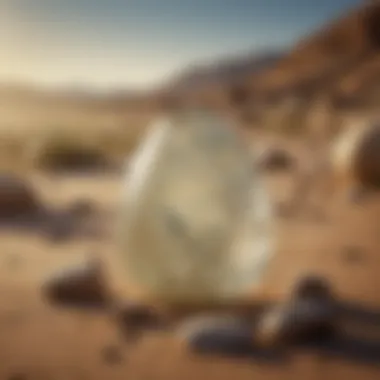
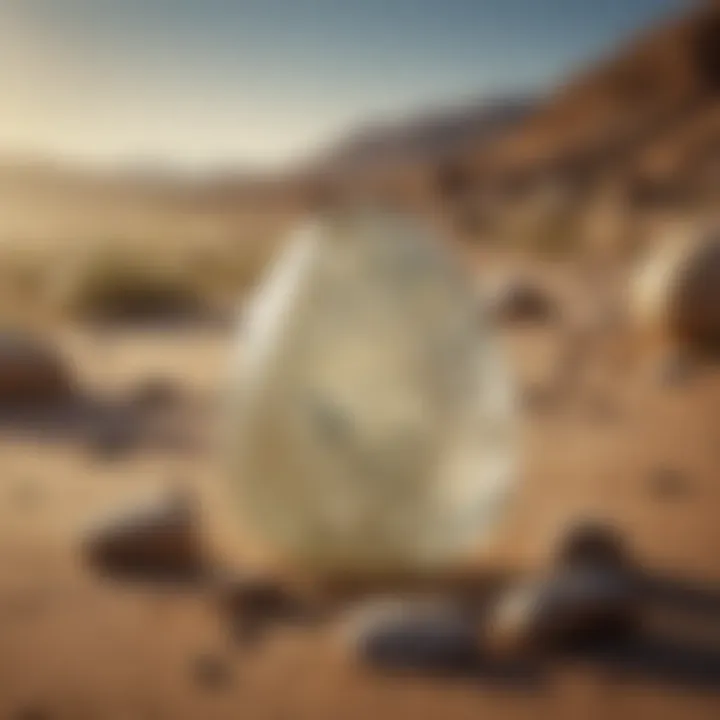
In summary, recognizing the geographical distribution of Libyan Desert Glass not only assists in its collection but also provides insight into its formation and the environmental forces at play.
Notable Sites of Discovery
There are several notable sites within Libya where Libyan Desert Glass has been discovered. One of the most famous locations is the Great Sand Sea, where vast patches of glass can be found. Here, the glass takes on various forms, including large, translucent pieces and smaller fragments intermixed with sand.
Other relevant sites include regions near the Gattar Depression and the Ubar al-Salabat. These areas have yielded significant quantities of glass, attracting both collectors and researchers. It's essential to note that while Libya is the primary location for this material, Libyan Desert Glass has been found in neighboring regions, though in smaller quantities.
Collectors should be cautious about legalities when attempting to acquire pieces from some areas, as certain countries have laws protecting geological artifacts. Thus, source identification remains crucial, and it adds another layer of complexity to the appreciation of this material.
"The intrigue of Libyan Desert Glass lies not only in its aesthetic beauty but also in the stories of its origins crafted by Earth's forces."
Applications in Various Fields
The exploration of Libyan Desert Glass extends beyond mere geological interest. Its roles in different sectors illustrate its significance and versatility. This section dissects the multifaceted applications of this unique tektite, emphasizing jewelry, art, and scientific research. Collectors and researchers may find the valuable insights here useful in determining both the functionality and the marketability of this extraordinary material.
Jewelry and Art
Libyan Desert Glass is highly sought after in the jewelry market. This includes both aesthetic and cultural value. Artisans utilize its distinct colors and textures, creating unique pieces that appeal to collectors. This glass can vary in shades – from pale yellow to rich greens – which enhances its attractiveness in handcrafted jewelry.
Furthermore, artisans appreciate its durability. Although it is classified as a glass, the hardness of Libyan Desert Glass makes it suitable for various forms of adornment. Its light-transmitting properties allow for striking designs, enhancing the visual impact of any piece.
"The allure of Libyan Desert Glass lies in its ancient origins and natural beauty, making it a perfect medium for creative expression."
Items such as necklaces, bracelets, and earrings crafted from Libyan Desert Glass reflect a confluence of nature and artistry, often selling at premium prices.
Moreover, artists are inspired by the glass's history and origin, employing them to evoke themes related to nature and time. Its incorporation into sculptures and installations lends an air of sophistication and intrigue. As an art form, Libyan Desert Glass transcends mere decoration, inviting conversation and exploration.
Scientific Research
Beyond its aesthetic qualities, Libyan Desert Glass serves a pivotal role in scientific inquiries. Geologists and archeologists study it to unravel past events of Earth's history. The study of its formation conditions provides insights into the geological processes that shape our planet.
Researchers utilize advanced spectroscopy techniques to analyze the chemical composition of Libyan Desert Glass. This helps in verifying origin theories, discerning between meteorite impacts and volcanic activities. Additionally, its unique isotopic signatures offer clues about the temperature and pressure conditions during formation.
Furthermore, scientists explore its potential applications in modern technologies. For instance, its physical properties can be studied for use in high-temperature insulation materials or in glass ceramics. Thus, the scientific community continues to validate the importance of Libyan Desert Glass not only as a historical artifact but also as a material with potential modern-day applications.
Market Value and Collectability
The market value and collectability of Libyan Desert Glass accentuate its significance among collectors and researchers alike. Understanding these concepts can help enthusiasts gauge the importance of this unique material, while also navigating the complex landscape of buying and selling tektites.
Determining Value
Value relies on various factors. First, the size of the Libyan Desert Glass specimen plays a vital role. Larger pieces usually command higher prices due to their rarity; however, shape and aesthetic quality also matter. For example, well-formed pieces with distinctive features or unique colors may fetch premium prices, while irregular fragments might not be as valuable.
Another critical factor is provenance. A piece with a documented history is often perceived as more valuable. For example, specimens sourced from notable locations or those that can be linked back to recognized collectors can elevate a tektite's worth in the eyes of buyers.
The current demand within the tektite collector community also influences value. Buyers tend to seek out pieces with an intriguing history or unusual characteristics. Typically, auctions and sales at specialized events can provide insights into market trends, helping potential sellers determine a fair price for their collection.
"The value of a Libyan Desert Glass tektite is a reflection of its uniqueness, condition, and provenance."
Buying and Selling Trends
The market for Libyan Desert Glass exhibits distinct patterns that collectors need to understand. Online platforms, such as eBay and Etsy, have become popular venues for buyers and sellers to connect. These platforms often showcase a range of prices for similar items, allowing collectors to assess the market more effectively.
Seasonal trends can also impact buying behavior. Certain times of the year, particularly around holidays or during specific conventions, see a surge in demand. This can lead to increases in prices as collectors scramble to add these items to their collections.
Social media groups, particularly on Reddit and Facebook, serve as fertile ground for discussions about trends and values. Collectors share their recent acquisitions and experiences, providing valuable insights into where the market is heading. Keeping abreast of these discussions can aid collectors in making informed buying and selling decisions.
Additionally, the rise of interest in natural history and geology contributes to a more vibrant market. As awareness of Libyan Desert Glass grows, so does the curiosity surrounding its origin and properties. Therefore, staying connected with the community can lead to better opportunities for both purchasing and selling.
Conservation and Preservation
Conservation and preservation of Libyan Desert Glass are essential for both scientific and aesthetic reasons. These tektites, formed under unique geological conditions, hold significant cultural and historical value. Protecting them ensures that future generations can study and appreciate these natural artifacts. Moreover, their rarity necessitates responsible stewardship to prevent damage and loss.
Effective conservation involves several key elements that collectors and enthusiasts must consider. Understanding the proper methods of storage and cleaning can help maintain the integrity of these pieces over time. As Libyan Desert Glass can be sensitive to certain environmental factors, taking precautions against extreme temperatures and humidity is crucial for its longevity.
The benefits of conservation are manifold. They include the preservation of valuable knowledge embedded within these specimens and the enhancement of their aesthetic appeal. A well-conserved piece has more potential market value and can better captivate the interest of collectors and researchers alike.
Storing Libyan Desert Glass
Storing Libyan Desert Glass correctly is vital for its preservation. The optimal conditions for storage include a cool, dry environment, away from direct sunlight. Prolonged exposure to UV light can lead to colors fading and potentially damaging the glass.
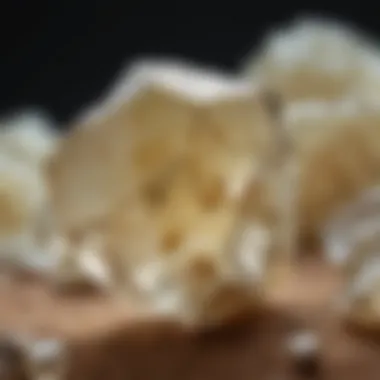
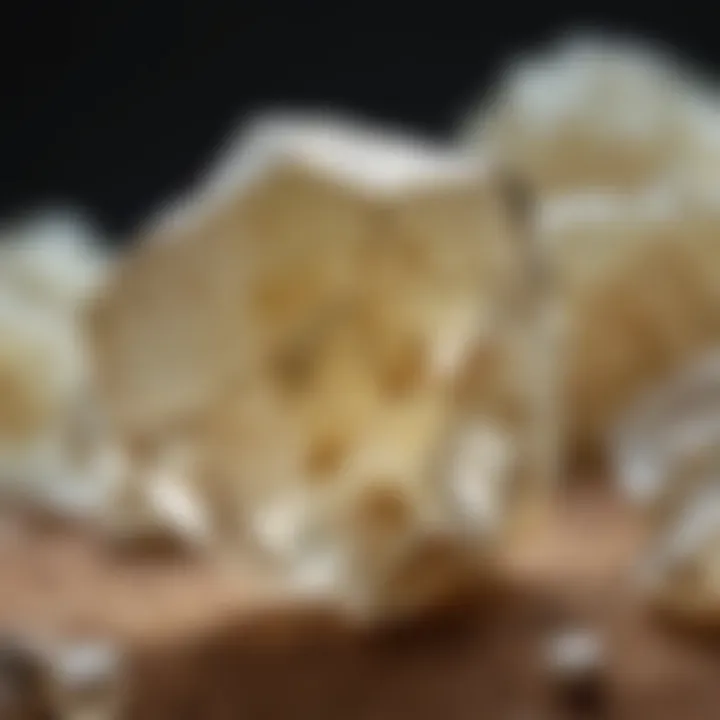
When storing, consider the following tips:
- Use acid-free boxes or containers to prevent reactions that could alter the glass.
- Avoid stacking multiple pieces directly on each other to minimize scratches and chips.
- Utilize padded wrapping materials for extra protection if needed.
Additionally, maintaining a consistent temperature helps prevent contractions and expansions that could impact the structural integrity of the glass. Each piece should be stored individually, which reduces the risk of accidental damage.
Cleaning Techniques
Cleaning Libyan Desert Glass requires care to avoid damaging its surface. Regular cleaning can help maintain its clarity and brilliance.
Here are effective cleaning techniques to ensure proper maintenance:
- Soft cloths: Use a non-abrasive, lint-free cloth for gentle wiping.
- Mild soap solution: Occasionally, a mild soap mixed with water can be used. Rinse it thoroughly to remove any residue.
- Avoid harsh chemicals: Never use bleach or ammonia-based cleaners, as these can dull the surface finish.
After cleaning, ensure that each piece is dried completely to prevent water spots. Always handle with clean hands or wear gloves to prevent oils from skin from transferring.
"Storing and cleaning are not just maintenance tasks but are acts of appreciation for the natural beauty of Libyan Desert Glass."
By adhering to these guidelines, collectors can aid in the conservation of Libyan Desert Glass, ensuring that these beautiful tektites remain appreciated and preserved for years to come.
Libyan Desert Glass in Popular Culture
Libyan Desert Glass has carved a niche for itself in popular culture. It not only fascinates mineral enthusiasts but also intrigues artists, authors, and filmmakers. The unique characteristics of this tektite elevate its status beyond mere geological interest. This section explores how Libyan Desert Glass is perceived in literature and modern media, shedding light on its cultural significance.
References in Literature
Literary references often reflect the profound impact of natural elements on human imagination. Libyan Desert Glass appears in various works, highlighting themes of mystery and allure. Authors have found inspiration in its unique properties and intriguing origins. For instance, some fiction writers incorporate the glass as a symbol of ancient knowledge or alien origins, stimulating readers' curiosity about our universe.
Such narratives may not always be scientifically grounded but they serve to engage the public’s interest in geology and mineralogy. The concept of Libyan Desert Glass as an artifact connects readers to the past, invoking an appreciation for the Earth's natural history.
Role in Modern Media
In contemporary media, Libyan Desert Glass features prominently in documentaries and educational programs. These presentations delve into its formation and significance, appealing to a wider audience. Furthermore, various online platforms, including social media, showcase the glass’s beauty and rarity, often leading to a surge in interest among collectors.
Rock and fossil enthusiasts often share their finds on forums like Reddit and Facebook, discussing the details of each specimen. Social media content related to Libyan Desert Glass often draws significant engagement, highlighting the complexities behind its formation and appeal.
"Libyan Desert Glass is not just a geological wonder, but a bridge connecting humanity with the cosmos."
Through these channels, more individuals discover the fascinating stories behind Libyan Desert Glass. This encourages an appreciation for its scientific and aesthetic value while fostering a community of enthusiasts.
Overall, Libyan Desert Glass serves as a cultural touchstone, representing the interplay between natural history and human curiosity.
The Future of Libyan Desert Glass Research
Research on Libyan Desert Glass is ongoing and presents numerous opportunities for advancement. This field is essential for understanding the Earth's geological processes and the natural phenomena that lead to the creation of these unique tektites. As our scientific capabilities improve, so too does our potential to gain deeper insights into the history and formation of this geological wonder.
Ongoing Studies and Discoveries
Current studies on Libyan Desert Glass focus on several critical areas:
- Geochemical Analysis: Researchers are conducting advanced tests to better understand the glass's chemical structure. This informs theories regarding its origin and the conditions under which it formed.
- Field Exploration: New expeditions are happening in the Libyan Desert, promoting the discovery of previously unknown sites of Libyan Desert Glass. These explorations increase the specimen pool available for research and collection.
- Dating Techniques: Scientists are working on more precise dating methods to ascertain the timeline of the glass's formation. This can help clarify historical climate shifts and environmental conditions.
These ongoing studies aim not only to expand knowledge but also to simulate conditions that may lead to the formation of similar materials elsewhere. As we discover more, our understanding of mineral formation under extreme temperatures and pressures may evolve.
Technological Advances in Analysis
Technological improvements are transforming how we analyze Libyan Desert Glass. Innovations include:
- Laser Ablation ICP-MS: This method allows for high-resolution chemical analysis of trace elements. It provides detailed insights into the glass’s composition without damaging the sample.
- X-Ray Diffraction (XRD): XRD is crucial in identifying crystalline forms and can discern between different types of glass, including distinguishing Libyan Desert Glass from other similar materials.
- Digital Microscopy: Advanced imaging techniques are enabling scientists to visualize the microstructural characteristics of the glass. This enhances our understanding of its formation processes and properties.
Adapting these technologies in studies not only enriches our comprehension but also opens new avenues for research across geology and environmental science. As we refine our methodologies, the future of Libyan Desert Glass research looks promising.
Culmination
The conclusion serves as a crucial point in the article, synthesizing key insights into Libyan Desert Glass tektites. The complex phænomenon of this natural artifact entails understanding its formation, properties, origins, and applications clearly. Highlighting these points contributes to a broader knowledge base that benefits both collectors and researchers. Furthermore, the conclusions drawn about its unique features enhance appreciation for this rare material, stirring curiosity about its implications in various fields. The importance lies not only in summarizing key elements but also in encouraging further exploration, thus fostering a deeper connection between enthusiasts and the scientific community.
Summary of Key Points
In this article, several significant elements about Libyan Desert Glass were discussed. Here are the key takeaways:
- Definition and Origins: Libyan Desert Glass, a type of tektite, has intriguing hypotheses regarding its formation, chiefly linked to meteorite impacts or volcanic activity.
- Physical and Chemical Properties: The glass exhibits unique colors and transparency, derived from its specific chemical makeup, which includes silica and other trace elements.
- Historical Importance: Initially thought to have been used in ancient artifacts, its historical significance enriches the cultural narrative of the regions where it is found.
- Market Value: Collectibility is high among rock and fossil collectors, making understanding its market dynamics essential for enthusiasts and investors.
- Conservation Practices: Proper storage and cleaning of Libyan Desert Glass are vital for preserving its beauty and integrity.
By summarizing these insights, readers can internalize the importance of Libyan Desert Glass and its multifaceted nature.
Implications for Enthusiasts and Researchers
The implications discussed in this section are significant for both enthusiasts and researchers. For collectors, understanding the properties and origins of Libyan Desert Glass enhances its value and appeal. Recognizing the rarity of the material can inform purchasing decisions. Researchers benefit from the scientific inquiries surrounding Libyan Desert Glass, which can yield valuable data for geology, history, and material science.
Considerations include:
- Networking Opportunities: Engaging with other enthusiasts and researchers can open avenues for further study and discovery.
- Publications and Studies: Sharing findings in relevant academic or collector circles can lead to greater recognition of the material and its unique attributes.
- Conservation Efforts: Supporting conservation initiatives may protect valuable specimens for future generations.
Understanding Libyan Desert Glass is not merely an academic pursuit; it enriches the appreciation for natural history and promotes a collaborative spirit among collectors and researchers alike.



